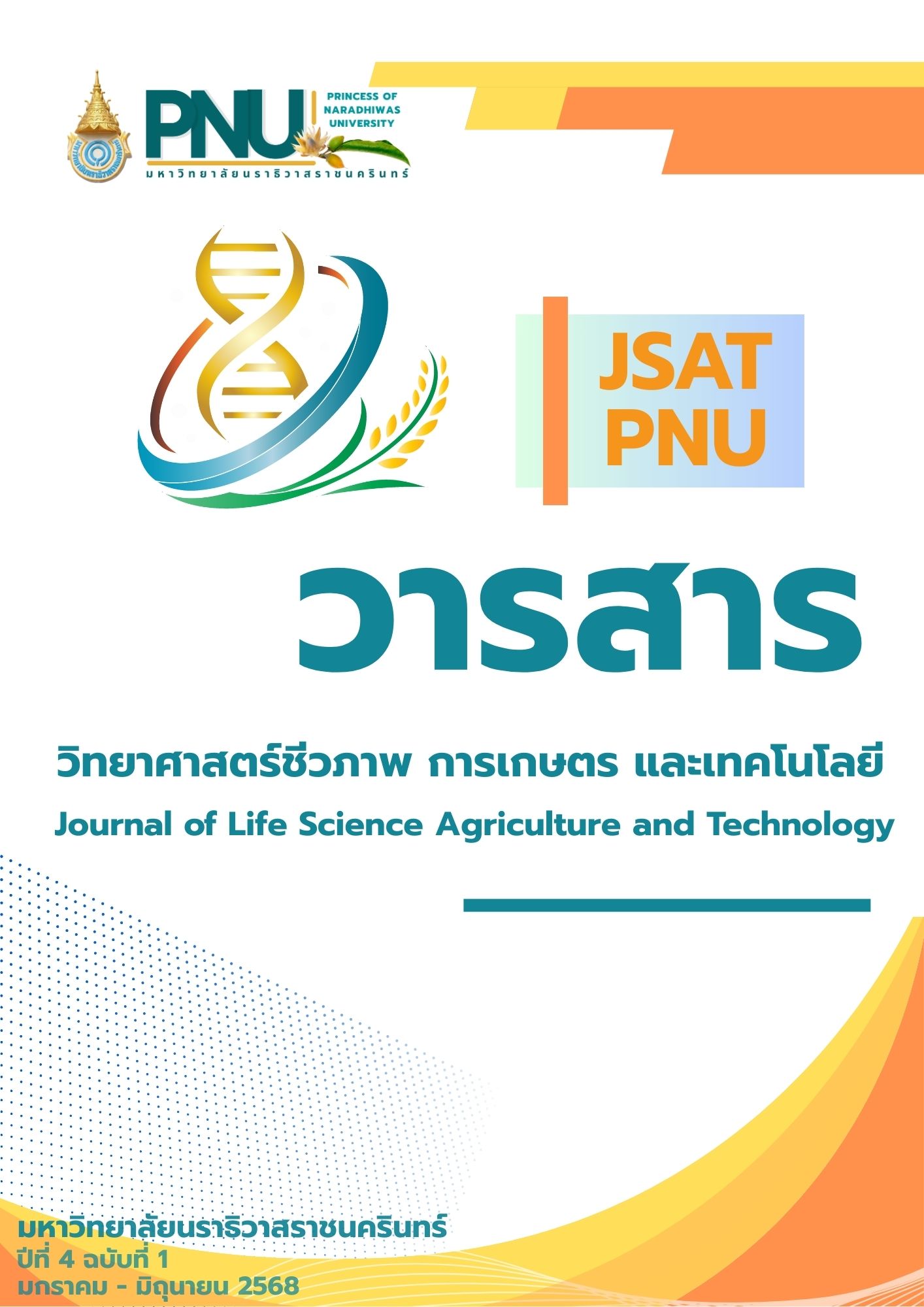Appropriate Nutrient Management to Improve Sugarcane Yield on Sandy Soils in Uthai Thani Province.
Keywords:
sugarcane, nutrient management, fertilizer application according to soil analysisAbstract
An effective nutrient management for sugarcane production on sandy soil was investigated. This aimed to be a guideline of fertilizer recommendation for sugarcane production on sandy soil in the central region of Thailand. The experiment was conducted by planting cane 4 generations; plant cane, first ratoon, second ratoon, and third ratoon cane in October 2016 to September 2020 at Sawang-arom district, Uthaithani province. Experimental design was Randomized Completely Block design with 4 replications and 5 treatments; 1) conventional fertilizer application 2) N-P-K fertilizer application at the recommend rate based on soil analysis 3) N-P-K-Mg fertilizer application at the recommend rate based on soil analysis 4) N-P-K-Zn fertilizer application at the recommend rate based on soil analysis and 5) N-P-K-Mg-Zn fertilizer application at the recommend rate based on soil analysis . The results showed that sugarcane fertilized according to soil analysis has sufficient amounts of potassium, calcium, iron and zinc for plant growth. N-P-K-Mg-Zn fertilizer application at the recommend rate based on soil analysis causes the third ratoon cane to grow in terms of number of shoots and number of stalks per clump. The first and third ratoon cane applied N-P-K-Mg-Zn base on soil analysis yielded 17.98 and 10.94 tons/rai and significantly higher than conventional fertilizer application which yielded 12.34 and 7.56 tons/rai. The average income of 4 generations cane production applied with fertilizer according to soil analysis was 3,125 baht/rai or 30.23 percent higher than that of the conventional fertilizer application due to the 25.24 reduction percentage of fertilizer cost.
References
กรมวิชาการเกษตร. (2553). คำแนะนำการใช้ปุ๋ยกับพืชเศรษฐกิจ. กรมวิชาการเกษตร.
ทักษิณา ศันสยะวิชัย. (2556). การจัดการไร่อ้อย. เอกสารประกอบการบรรยายการฝึกอบรมหลักสูตรการปลูกอ้อยและการเพิ่มประสิทธิภาพการผลิตในพื้นที่ปลูกใหม่. วันที่ 16 สิงหาคม 2556 ณ ห้องประชุมที่ว่าการอำเภอภูสิงห์ จังหวัดศรีสะเกษ.
ยงยุทธ โอสถสภา. (2546). ธาตุอาหารพืช (พิมพ์ครั้งที่ 2). มหาวิทยาลัยเกษตรศาสตร์.
วิภาวรรณ ท้ายเหมือง สุชาดา กรุณา ศิวโรจน์ สุวรรณโณ และอาณัติ เฮงเจริญ. (2562). ผลของปุ๋ยโพแทสเซียม แมกนีเซียม และสังกะสีต่อผลผลิตและคุณภาพผลผลิตอ้อยตอ 1 ในชุดดินโคราช. วารสารแก่นเกษตร, 47(4), 739-748.
สถาบันวิจัยพืชไร่. (2544) เอกสารวิชาการ พันธุ์ การปลูกดูแลรักษาอ้อย. สถาบันวิจัยพืชไร่ กรมวิชาการเกษตร.
สำนักงานคณะกรรมการอ้อยและน้ำตาลทราย. (2567). รายงานสถานการณ์การปลูกอ้อยปีการผลิต 2566/2567. กลุ่มเทคโนโลยีสารสนเทศและการสื่อสาร กองยุทธศาสตร์และแผนงาน สำนักงานคณะกรรมการอ้อยและน้ำตาลทราย.
สำนักงานเศรษฐกิจการเกษตร. (2567). สถิติการค้าสินค้าเกษตรไทยกับต่างประเทศปี 2566. สำนักงานเศรษฐกิจการเกษตร.
สำนักงานเศรษฐกิจการเกษตร. (2568). สถิติการเกษตรของประเทศไทยปี 2567. สำนักงานเศรษฐกิจการเกษตร.
อนุชา เหลาเคน นิพนธ์ ภาชนะวรรณ สุชาติ คำอ่อน ทักษิณา ศันสยะวิชัย และจักรพรรดิ วุ้นสีแซง. (2557). การทดสอบการใช้ปุ๋ยเพื่อเพิ่มผลผลิตอ้อยพันธุ์ขอนแก่น 3 ที่ปลูกในเขตอาศัยน้ำฝนจังหวัดมหาสารคาม. วารสารแก่นเกษตร, 42(ฉบับพิเศษ 2), 13-141.
Anderson, D.L. and Bowen J.E. (1990). Sugarcane nutrition. Potash and phosphate institute of Canada, Foundation for Agronomic Research Atlanta Georgia USA.
Bray, R.H., and L.T. Kurtz. (1945). Determination of total organic and available forms of phosphorus in soils. Soil Sci, 59, 39-45.
Blackburn, F. (1984). Sugarcane. Longman, Inc., New York.
Calcino, D.V. (2010). Australian sugarcane nutrition manual. Soil and Sugarcane Growth, BSES Limited.
Mellis, E.V., J.A. Quaggio, L.A.J. Teixeira, and H. Cantarella. (2011). Sugarcane response to zinc application. In: 3rd International Zinc Symposium, Hyderabad, India. 119 pp.
Lindsay, W,L., and W.A. Norvell. (1978). Development of a DTPA soil test for zinc, iron, manganese, and copper. Soil Sci, 42, 421-428.
Panhwar, M.W., S.S Joshi and V.T. Amodker. (2003). Effect of foliar application of phosphorus and micronutrients on enzyme activities and juice quality in sugar cane. Sugar Tech. 5(3), 161-165.
Peech, M. 1965. Hydrogen Ion Actvity. pp. 914-926. In C. A. Black, D.D. Evans, L.E. Ensminger, and F.E. Clark (eds.). Method of Soil Analysis. American Society of Agronomy. adison. Wisconsin. USA.
Romheld V. and M. Nikolic. (2007). Iron. In Handbook of plant nutrition. A.V. Barker and D.J. Pilbeam. CPC Press. New York. 773 pp.
Schollenberger, C.J., and R.H. Simon. (1945). Determination of exchange capacity and exchangeable bases in soils-ammonium acetate method. Soil Sci, 59, 13-24.
Walkley, and I.A. Black. (1934). An examination of Degtjareff method of determining soil organic matter and a proposed modification of the chromic acid titration method. Soil Sci, 37, 29-37.
Downloads
Published
How to Cite
Issue
Section
License
Copyright (c) 2025 Journal of Science, Agriculture and Technology

This work is licensed under a Creative Commons Attribution-NonCommercial-NoDerivatives 4.0 International License.
ข้อความลิขสิทธิ์ เติมด้วยค่ะ






